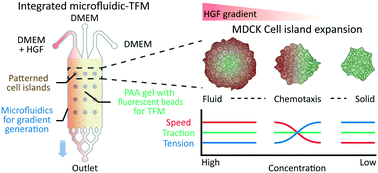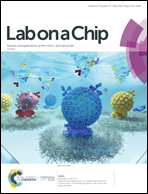Traction microscopy with integrated microfluidics: responses of the multi-cellular island to gradients of HGF†
Abstract
Collective cellular migration plays a central role in development, regeneration, and metastasis. In these processes, mechanical interactions between cells are fundamental but measurement of these interactions is often hampered by technical limitations. To overcome some of these limitations, here we describe a system that integrates microfluidics with traction microscopy (TM). Using this system we can measure simultaneously, and in real time, migration speeds, tractions, and intercellular tension throughout an island of confluent Madin–Darby canine kidney (MDCK) cells. The cell island is exposed to hepatocyte growth factor (HGF) at a controlled gradient of concentrations; HGF is known to elicit epithelial-to-mesenchymal transition (EMT) and cell scattering. As expected, the rate of expansion of the cell island was dependent on the concentration of HGF. Higher concentrations of HGF reduced intercellular tensions, as expected during EMT. A novel finding, however, is that the effects of HGF concentration and its gradient were seen within an island. This integrated experimental system thus provides an integrated tool to better understand cellular forces during collective cellular migration under chemical gradients.

- This article is part of the themed collection: Lab on a Chip Recent HOT Articles


 Please wait while we load your content...
Please wait while we load your content...